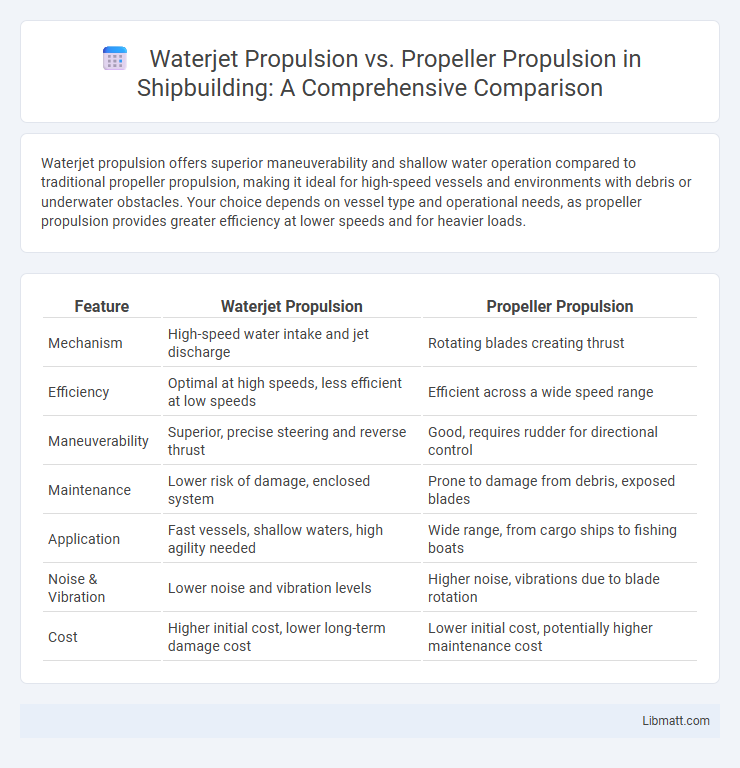Waterjet propulsion offers superior maneuverability and shallow water operation compared to traditional propeller propulsion, making it ideal for high-speed vessels and environments with debris or underwater obstacles. Your choice depends on vessel type and operational needs, as propeller propulsion provides greater efficiency at lower speeds and for heavier loads.
Table of Comparison
| Feature | Waterjet Propulsion | Propeller Propulsion |
|---|---|---|
| Mechanism | High-speed water intake and jet discharge | Rotating blades creating thrust |
| Efficiency | Optimal at high speeds, less efficient at low speeds | Efficient across a wide speed range |
| Maneuverability | Superior, precise steering and reverse thrust | Good, requires rudder for directional control |
| Maintenance | Lower risk of damage, enclosed system | Prone to damage from debris, exposed blades |
| Application | Fast vessels, shallow waters, high agility needed | Wide range, from cargo ships to fishing boats |
| Noise & Vibration | Lower noise and vibration levels | Higher noise, vibrations due to blade rotation |
| Cost | Higher initial cost, lower long-term damage cost | Lower initial cost, potentially higher maintenance cost |
Introduction to Marine Propulsion Systems
Marine propulsion systems primarily consist of waterjet propulsion and propeller propulsion, each offering distinct advantages for vessel performance. Waterjet propulsion excels in shallow waters and high-speed applications by ejecting water at high velocity, enhancing maneuverability and reducing the risk of damage from debris. Propeller propulsion remains widely used for its efficiency in various marine vessels, providing reliable thrust through rotating blades, optimal for steady cruising and heavy-duty tasks.
Overview of Waterjet Propulsion
Waterjet propulsion uses high-pressure water ejected through a nozzle to generate thrust, providing enhanced maneuverability and shallow draft capabilities compared to traditional propeller propulsion. This system reduces cavitation and improves safety in environments with debris or swimmers, making it ideal for high-speed vessels and rescue operations. Your choice of waterjet propulsion can lead to increased efficiency and lower maintenance in specific marine conditions.
Overview of Propeller Propulsion
Propeller propulsion relies on rotating blades to generate thrust by pushing water backward, effectively converting engine power into forward movement. This method provides high efficiency at various speeds and is widely used in commercial and recreational vessels due to its reliability and straightforward maintenance. Your choice of propeller propulsion ensures optimized fuel consumption and strong maneuverability for many marine applications.
Efficiency Comparison: Waterjets vs Propellers
Waterjet propulsion offers superior maneuverability and efficiency at high speeds, especially in shallow waters, by minimizing drag and cavitation compared to traditional propellers. Propeller propulsion is generally more efficient at lower speeds and for vessels requiring high thrust, benefit from direct mechanical coupling and less energy loss. Efficiency comparisons largely depend on vessel type, operating speed, and water conditions, with waterjets excelling in fast, agile crafts and propellers favored for heavy-duty, low-speed operations.
Maneuverability and Handling Differences
Waterjet propulsion offers superior maneuverability and handling compared to propeller propulsion, enabling tighter turns and rapid acceleration due to the directionally controllable jets. Unlike traditional propellers that rely on rotating blades vulnerable to damage and limited responsiveness, waterjets provide instantaneous thrust vectoring, enhancing control especially in shallow or debris-filled waters. This results in improved agility and safer operation in environments requiring precise navigation.
Performance at Varying Speeds
Waterjet propulsion excels at high speeds due to its ability to maintain thrust efficiency and maneuverability, especially above 30 knots, while propeller propulsion offers superior efficiency and thrust at lower speeds, typically below 20 knots. Waterjets reduce cavitation and improve acceleration, making them ideal for fast vessels such as jet boats and military craft. Propellers generate better fuel economy and thrust at cruising speeds, benefiting slower ships like fishing boats and cargo vessels.
Maintenance and Durability Considerations
Waterjet propulsion systems generally require less maintenance due to fewer moving parts exposed to debris and reduced risk of corrosion in shallow or debris-filled waters. Propeller propulsion often demands more frequent inspection and repairs from damage caused by underwater obstacles and marine growth, impacting overall durability. Choosing waterjet propulsion can enhance your vessel's longevity and reduce downtime compared to traditional propeller systems.
Safety Aspects of Both Propulsion Types
Waterjet propulsion offers enhanced safety due to its enclosed intake and no exposed rotating blades, reducing injury risks to swimmers and marine life compared to traditional propeller propulsion. Propeller systems pose higher hazards because of their open, fast-spinning blades that can cause severe injuries or damage on contact. Your choice impacts safety precautions, with waterjets generally preferred in environments where human interaction with the watercraft is frequent.
Applications Best Suited for Waterjets and Propellers
Waterjet propulsion excels in high-speed vessels such as jet boats, rescue crafts, and military patrol boats, where shallow draft and maneuverability are critical. Propeller propulsion is best suited for commercial ships, fishing boats, and large yachts requiring efficient fuel consumption and robust thrust at varying speeds. The choice depends on operational environments: waterjets perform well in shallow, debris-filled waters, while propellers maximize efficiency in deeper, open waters.
Future Trends in Marine Propulsion Technology
Waterjet propulsion is increasingly favored in marine applications for its superior maneuverability, higher speeds, and reduced underwater noise compared to traditional propeller propulsion. Future trends highlight advancements in hybrid systems combining electric power with waterjets to boost energy efficiency and lower environmental impact. Your choice of propulsion will benefit from innovations in smart control systems that optimize performance and durability in varied marine environments.
Waterjet propulsion vs propeller propulsion Infographic

 libmatt.com
libmatt.com